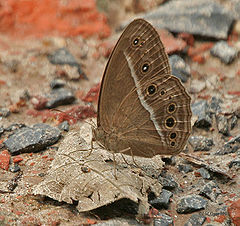- Mycalesis mineus
-
Dark-branded Bushbrown 
Wet-season form Conservation status Not evaluated (IUCN 2.3)Scientific classification Kingdom: Animalia Phylum: Arthropoda Class: Insecta Order: Lepidoptera Family: Nymphalidae Genus: Mycalesis Species: M. mineus Binomial name Mycalesis mineus
(Linnaeus, 1758)The Dark-branded Bushbrown, Mycalesis mineus, is a species of satyrine butterfly found in Asia.
Description
Wet-season form.— Upperside dark vandyke-brown; fore and hind wings with slender subterminai and terminal pale lines. Fore wing with a single white-centred, fulvous-ringed, black ocellus, generally set in a square pale area, in interspace 2, occasionally a similar smaller ocellus without any pale surrounding area in interspace 5. Hind wing uniform sometimes with one or two obscure postmedian ocelli. Underside: ground-colour similar; fore and hind wings crossed by a transverse dusky-white discal band, well-defined inwardly, diffuse outwardly, followed by a post-discal series of ocelli surrounded by a dusky-yellowish, sometimes purplish-white, line; the ocelli are similar to the ocelli on the upperside, and vary from two to four on the fore and from five to seven (the preapical two being sometimes obsolescent) on the hind wing; of these latter the posterior four, not three as in Mycalesis perseus, are in a straight line; finally, beyond the rows of ocelli on both wings there are pale or purplish-white subterminal and terminal sinuous lines.
Dry-season form. Upperside similar to that in the wet-season form, but paler. Underside from ochraceous brown to dusky brown of a darker shade ; basal half of the wings conspicuously darker than the outer portions ; the whole surface irrorated with fine brown striae ; sometimes a distinct dark discal band crosses both wings; ocelli nearly obsolete, indicated by minute white specks, the posterior four on the hind wing in a straight line as in the wet-season form. Antennae, head, thorax and abdomen brown; the club of the antennae with black and ochraceous marks. Male sex-mark in form 1 as in M. perseus, but the patch of specialized scales on the underside of the fore wing half as large again.[1]
Footnotes
- ^ Bingham (1905)
References
- Bingham, C.T. (1905): The Fauna of British India, Including Ceylon and Burma. Lepidoptera, Volume 1

This Satyrinae article is a stub. You can help Wikipedia by expanding it.


